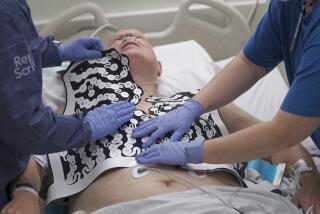Stem cells for broken hearts
- Share via
It’s one of the most vexing problems in medical science: How can you mend a broken heart?
A decade ago, researchers and cardiologists thought they had found an answer in stem cells. These powerful cells lurk throughout the body, repairing and maintaining tissues as needed. In the laboratory, scientists can transform them into heart cells. When implanted in animals, they grow into new heart tissue too.
So it was with high hopes that researchers transfused stem cells into patients suffering from heart failure — people whose hearts, weakened by heart attacks or other conditions, no longer pumped enough blood through their bodies. But in clinical trials, the effects have been modest. Stem cells appeared to help, but not as much as doctors had hoped — and not in the ways they had expected.
Now those early results are pointing researchers toward other types of stem cells that may be better suited to help repair cardiac muscle. With 5 million Americans currently suffering from heart failure — and their ranks sure to grow as 76 million baby boomers march into old age — cardiologists are counting on breakthroughs in stem cell therapy.
“We’re trying to tear pages out of nature’s playbook,” says Dr. Douglas W. Losordo, director of the program in Cardiovascular Regenerative Medicine at Northwestern Memorial Hospital in Chicago.
Hearts and bones
As the era of regenerative medicine dawned, stem cells seemed a perfect candidate to rebuild damaged hearts.
The stem cells in bone marrow were particularly tantalizing. Long used to rebuild the immune systems of cancer patients, scientists discovered that they also have the capacity to grow into heart muscle, blood vessels and other tissues — at least under certain laboratory conditions. Bone marrow is easy to extract from patients, and the therapeutic cells derived from it are a perfect genetic match for patients, greatly reducing the risk of tissue rejection.
Researchers and clinicians imagined using stem cells to undo the damage caused by a heart attack. In just a few minutes, a blockage in an artery can cut off oxygen to the heart, killing as many as a billion cells. The cells, for the most part, don’t grow back. Instead, what remains is scar tissue and a weakened circulatory system.
Heart attacks aren’t nearly as deadly as they used to be — more than 4 out of 5 heart attack victims are still alive after one year, according to a study last month in the American Journal of Medicine.
But the damage caused by a heart attack can result in heart failure — and patients diagnosed with heart failure have an average life expectancy of less than five years, according to Dr. Chuck Murry, director of the Center for Cardiovascular Biology at the University of Washington in Seattle.
“It’s deadlier than breast cancer,” Murry says.
That helps explain the enthusiasm for clinical trials involving stem cells from bone marrow. From 2002 to 2006 alone, there were at least 18 randomized controlled studies involving nearly 1,000 patients.
“Everyone started putting bone marrow in the heart,” says Christine Mummery, a researcher at Leiden University Medical Center in the Netherlands, who has studied how to turn stem cells into heart muscle cells called cardiomyocytes.
But the results, she says, were a mixed bag. The treatment appeared to be safe, but patients had only transient improvement.
“People went from being very sick to a little less sick,” Mummery says.
There is a silver lining: Even stem cells that don’t grow into new heart cells seem to help patients in other ways. As the bone marrow transplant trials continue, researchers are trying to sort it all out.
“It’s a little bit mysterious,” says Dr. Eduardo Marbán, director of the Cedars-Sinai Heart Institute in Los Angeles.
Marbán, like many, believes the improvements came about because transplanted cells secreted chemicals that boosted heart function — not because any new heart tissue grew. The “stem cells are working mostly by raising an alarm to resident cardiac stem cells. They seem to work indirectly.”
Hoping for a more direct approach that could generate new tissue, Marbán started studying stem cells that come from the heart instead of from bone marrow.
These so-called cardiac progenitor cells naturally repair heart muscle — but they do so far too slowly “to cope with a catastrophic injury” like a heart attack, Marbán says.
The cells are also rare, accounting for about 1 in every 40,000 working heart cells, he estimates. But in larger concentrations, they might be able to speed up the healing process.
To find out, Marbán is leading a trial involving patients who have suffered heart attacks within the past month. First a cardiologist threads a catheter through a patient’s neck and into his heart to collect “little snippets of tissue,” Marbán says. Those are then cultured in the lab for about a month, until the initial population of cardiac progenitor cells grows to tens of millions. Finally, they’re infused back into the patient’s heart through another catheter.
The hope is that the cardiac stem cells will take root and reverse the scar. Results should be out later this year. “Let’s just say we’re extremely encouraged,” Marbán says. “It looks like it’s working, and cleanly.”
Multipurpose cells
In other labs, researchers are focused on more powerful, pluripotent stem cells that have the potential to grow into any type of tissue in the body. Some labs are using embryonic stem cells, and others are studying induced pluripotent stem cells derived from adult tissues and rewound to an embryonic-like state.
“The only cell type that becomes a heart cell is a pluripotent stem cell,” says Dr. Deepak Srivastava, director of the Gladstone Institute of Cardiovascular Disease at UC San Francisco. If bone marrow stem cells or cardiac progenitor cells do manage to create new heart muscle, he says, “it will be a tiny amount.”
But research involving pluripotent stem cells is still preliminary. At the Harvard Stem Cell Institute in Boston, Dr. Kenneth Chien has grown mouse embryonic stem cells into a strip of mature cardiac tissue. But Chien’s “heart patch,” described in a 2009 edition of the journal Science, was only six to seven cell layers thick — too thin to work as a graft or grow blood vessels. He says he is now developing a three-dimensional cardiac muscle patch “akin to a heart Band-Aid.”
Any therapy derived from pluripotent stem cells is a long way from being ready to test in humans. Among other technical hurdles, replacement tissues grown from embryonic stem cells run the risk of rejection, just as with organ transplants. In addition, the same forces that make both types of stem cells so flexible also mean they have the potential to generate tumors. When pluripotent stem cells are used to grow heart cells, researchers have encountered difficulty getting them to beat in sync with surrounding heart tissue.
So some of the most promising work with pluripotent stem cells isn’t about making replacement heart tissue but finding other ways to ramp up the heart’s own healing abilities. For example, Srivastava’s lab has identified three genes that convert connective cells in the heart called fibroblasts directly into cardiomyocytes. Murry calls the research, which was published last year in the journal Cell, a potential “game changer.”
Northwestern’s Losordo has been studying stem cell treatments for about 14 years. He agrees that the best approach might be to apply what scientists have learned about creating stem cells to turn back the clock within a person’s own body. “If you can make a patient’s own cell behave as if it’s younger, problem solved.”
More to Read
Sign up for The Wild
We’ll help you find the best places to hike, bike and run, as well as the perfect silent spots for meditation and yoga.
You may occasionally receive promotional content from the Los Angeles Times.











